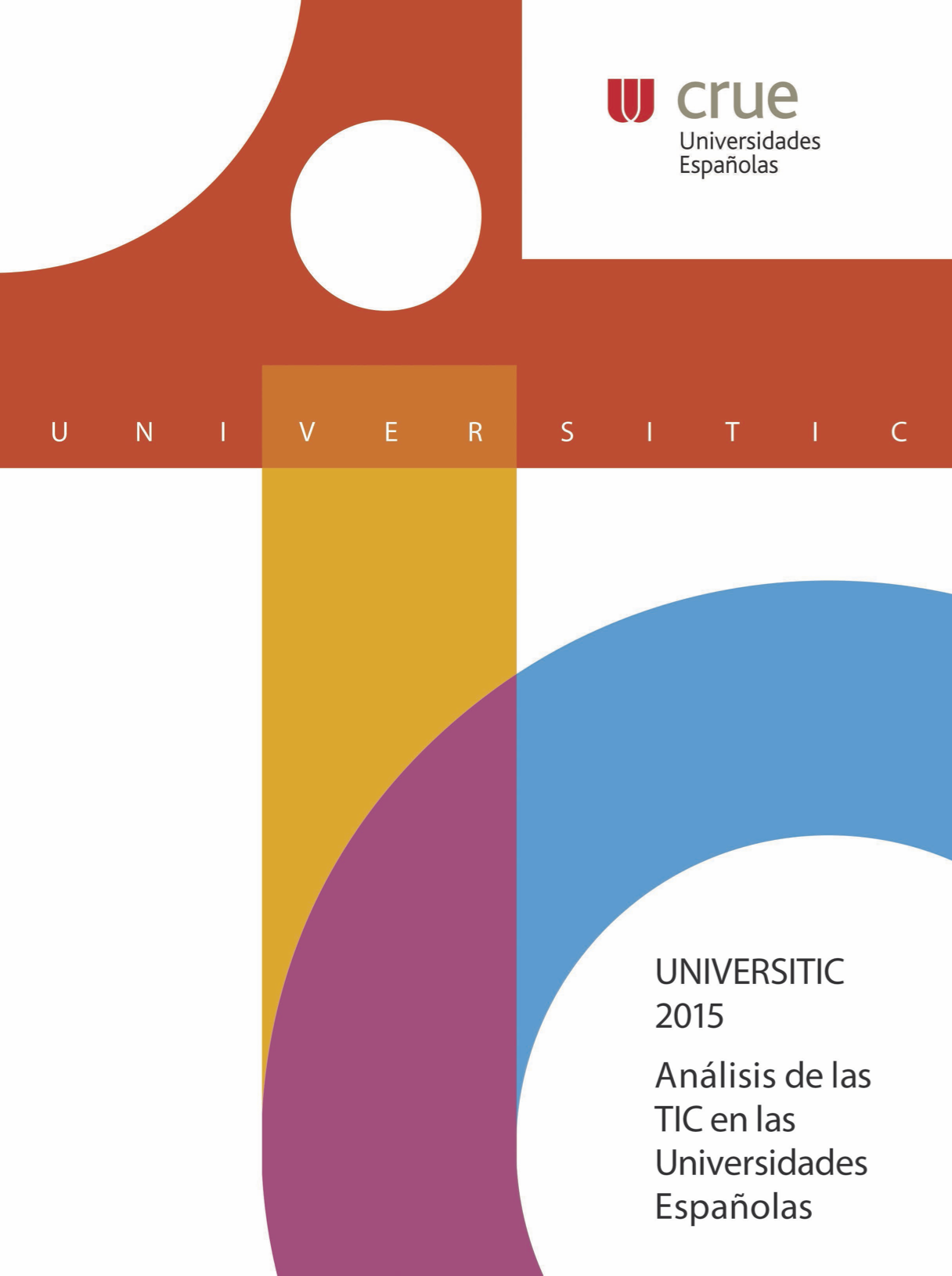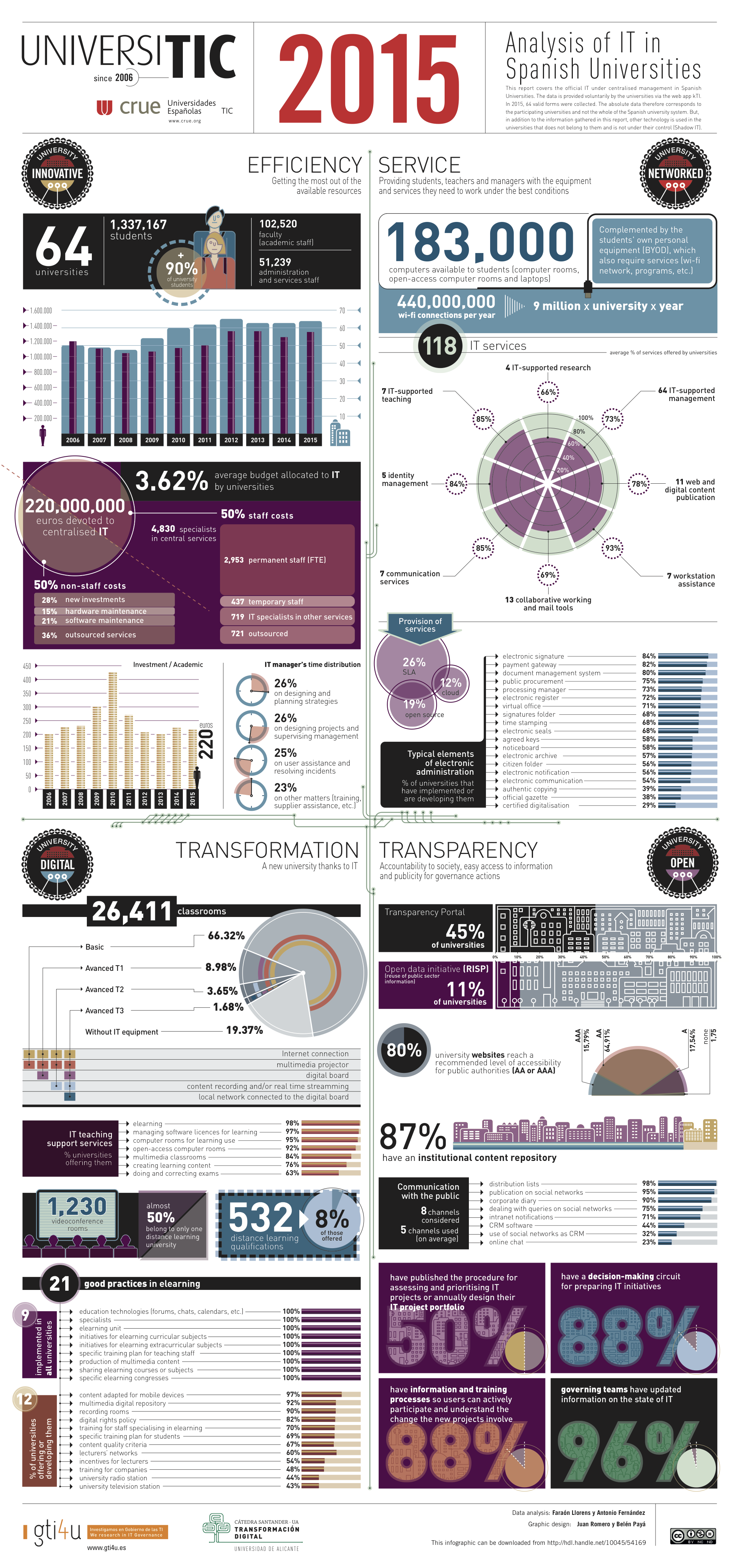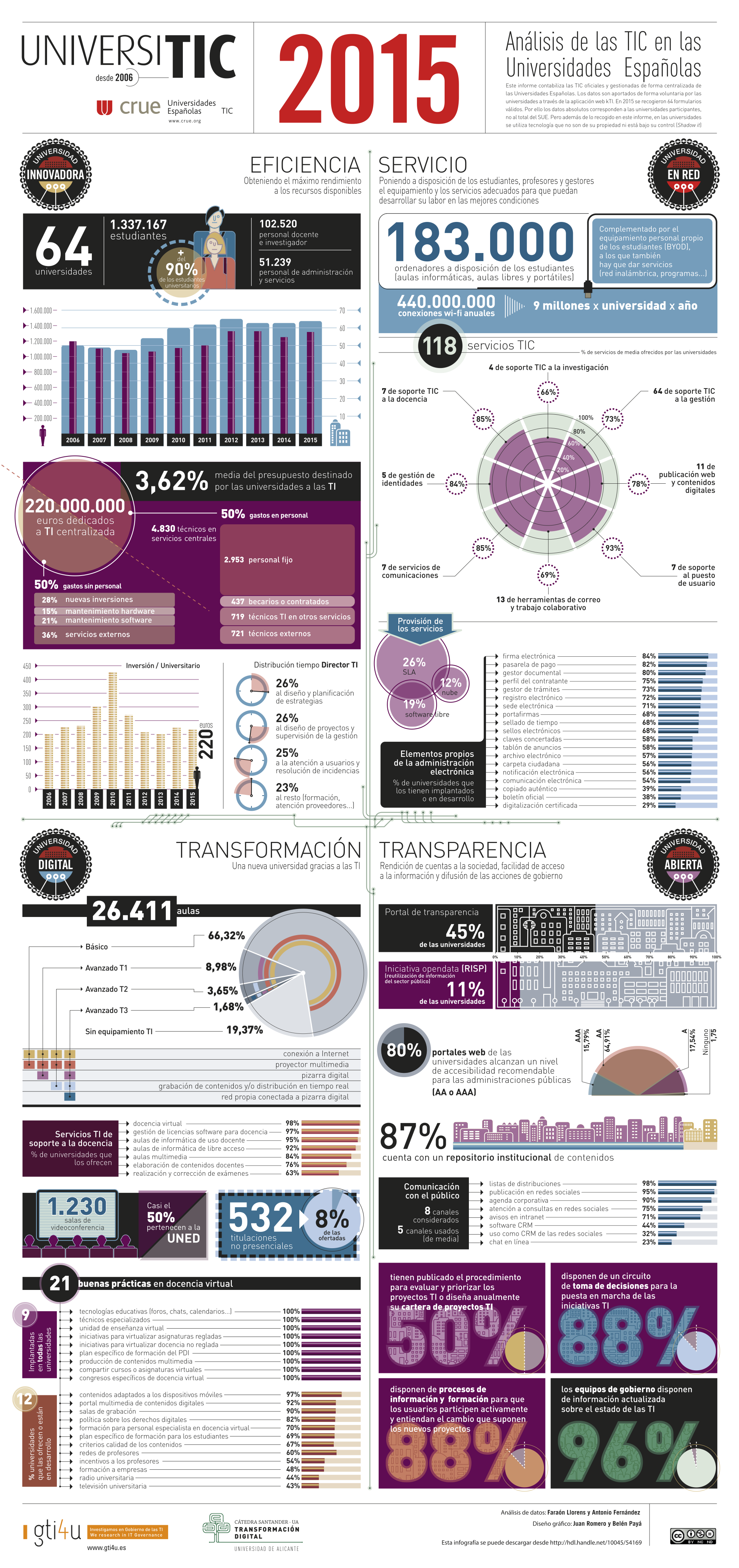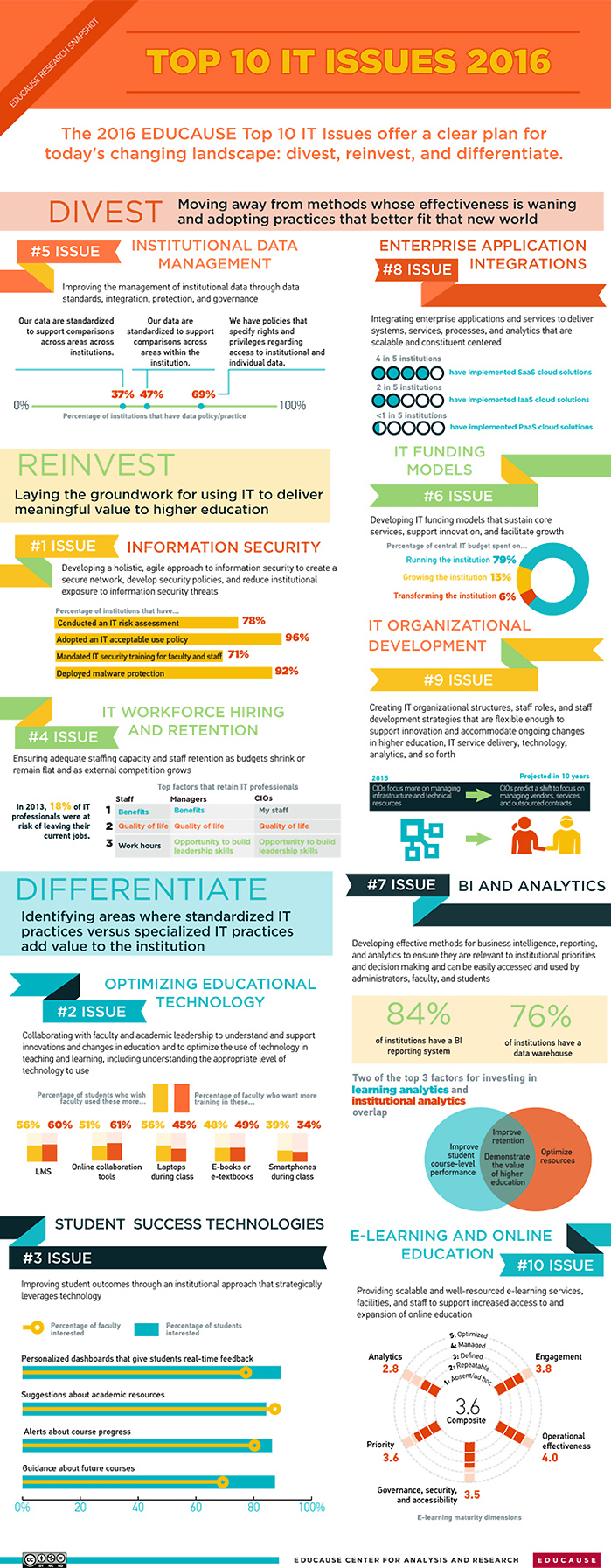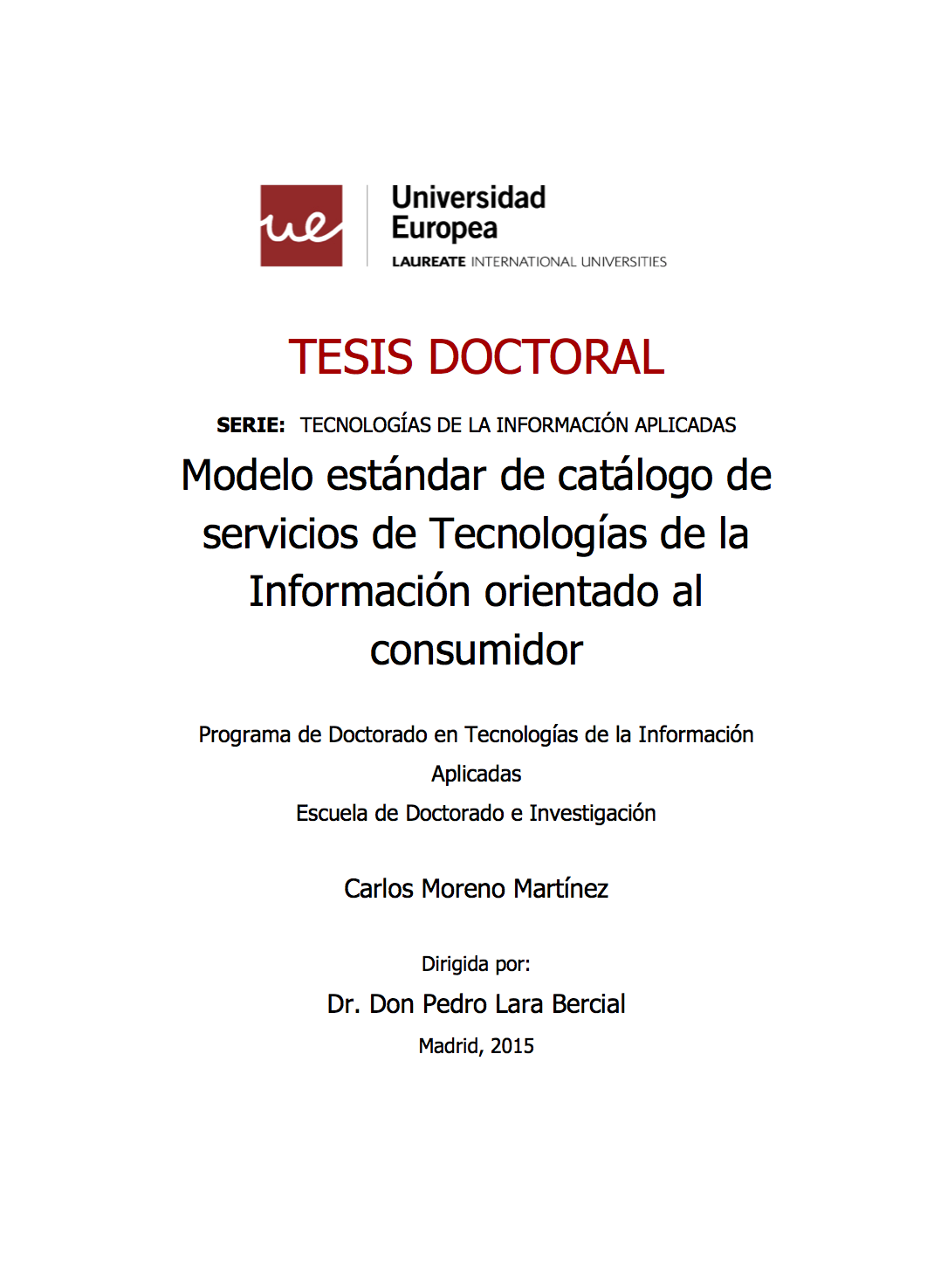Home » Gobierno de las TI (Page 13)
Category Archives: Gobierno de las TI
UNIVERSITIC 2015: análisis de las TIC en las Universidades Españolas
Hoy, 4 de julio, ha tenido lugar en Crue Universidades Españolas la presentación del informe UNIVERSITIC 2015 (noticia)
Como viene siendo habitual cada año, la Comisión Sectorial de Tecnologías de la Información y las Comunicaciones (TIC) de Crue Universidades Españolas ha publicado el informe UNIVERSITIC, que en su décima edición tiene por título UNIVERSITIC 2015: análisis de las TIC en la Universidades Españolas. El informe se basa en un catálogo de indicadores, actualizado en esta edición, que permite determinar la situación de las TI en las universidades españolas desde las perspectivas de descripción y gestión, disponiendo tanto de un inventario detallado y evidencias de uso como de una referencia de las buenas prácticas. Esta edición incorpora un tercer capítulo que, más allá de los datos, repasa la evolución del informe, hace un inventario detallado de la infraestructura TI de apoyo a la docencia, revisa el extenso catálogo de servicios y reflexiona sobre la figura del director de TI.
En esta edición se mantiene el excelente nivel de participación, con 64 universidades, que recogen el 90% de los estudiantes universitarios españoles.
Además en esta edición se ha realizado una infografía para facilitar su lectura y comprensión. También disponible en inglés (infographic)
Todas las ediciones de este informe se pueden encontrar en http://www.crue.org/SitePages/Universitic.aspx.
Solving the CIO’s Disruption Dilemma — the Blended IT Strategy
Solving the CIO’s Disruption Dilemma — the Blended IT Strategy
The Economist Intelligence Unit
April 20, 2016
http://businessvalueexchange.com
http://businessvalueexchange.com/blog/2016/04/20/solving-cios-disruption-dilemma-blended-strategy
The CIO, who is on the front line of digital disruption, faces a digital dilemma. First, disruption creates an urgent pressure for transformation. Long-established firms are being “Ubered” and “Amazoned”. Insurgents may be taking market share through lower costs, faster time-to-market and superior customer experience. In many firms, customers, competitors, CEOs and boards are looking to the CIO for rapid digital transformation and looking for it now.
But the CIO is also charged with providing the stable platform that supports ongoing operations. These are the operational sinews that process the orders, book the sales, schedule the parts and ensure regulatory compliance. Failure or down-time of these back-office processes, which often reside on legacy technologies, can be disastrous for the firm (and for the CIO).
The dilemma is amped up by pressures of risk and time. Accelerated transition can be high risk—data that does not integrate, systems that go down, more human error in an uncertain environment. Added to this is the risk factor of an overstretched IT department trying to make everything happen at once.
Finally, transformation isn’t just about machines—it is about people. For example, a bank may have IT personnel who are steeped in a culture of risk management, process and strict regulatory adherence. These are extremely valuable assets that cannot be morphed into agile, digital-savvy disruptors overnight.
UNIVERSITIC 2015 (infographic)
This infographic can be downloaded from http://hdl.handle.net/10045/54169
Leveraging information for high level-of- abstraction organizational processes
Leveraging information for high level-of- abstraction organizational processes
J.L. Dalmau-Espert, F. Llorens-Largo, P. Compañ-Rosique, R. Satorre-Cuerda, R. Molina-Carmona
Departamento de Ciencia de la Computación e Inteligencia Artificial
Universidad de Alicante
Big Data 2016
Alicante, 3-5 May 2016
http://www.wessex.ac.uk/conferences/2016/big-data-2016
Organisers
Wessex Institute, UK
University Miguel Hernandez, Spain
University of Alicante, Spain
Abstract
Nowadays, Big Data techniques have made possible to obtain interesting low- level information from large amounts of data. However, the information is often difficult to be enriched enough to aid in high-level organizational processes. The objective of this work is to define a model to allow the use of available information for the design and implementation of high level-of-abstraction processes that take place in the organizations. Particularly, this paper is focused on the Strategic Planning process, one of the most complex and abstract processes in any company. So far there are very few successful attempts to automate this process, which is usually based on manual tasks. At the most, the results from the automatic data analysis are generated and used as reports and are not integrated in the process. A further step is proposed, posing a Strategic Planning model based on a multi-agent system with a blackboard, which is used as a means of communication and storage of the generated information. The information is described using an ontology to formalize both the Strategic Planning process and the information used in each step. The combination of these elements enables the participation, interaction and sharing of information and knowledge of the participants in the process. The accumulated knowledge allows the use of previous experience to automate the process and improve the decision-making. In short, the proposed model is a formal, comprehensive, agile and flexible solution to perform the process of Strategic Planning in organizations today leveraging of the enormous amount of available data and the gathered experience.
UNIVERSITIC 2015 (infografía)
Esta infografía se puede descargar desde http://hdl.handle.net/10045/54169
Tecnologías que ningún CIO del sector educativo debería ignorar
Tecnologías que ningún CIO del sector educativo debería ignorar
Los líderes de instituciones de educación superior han pasado de centrarse en reducir costes y ser más eficientes a utilizar la tecnología para mejorar la competitividad y soportar nuevos modelos de negocio, según Gartner. La consultora identifica 10 tecnologías que los CIO de este sector no pueden permitirse perder de vista.
http://www.ciospain.es/aapp/tecnologias-que-ningun-cio-del-sector-educativo-deberia-ignorar-i
http://www.ciospain.es/aapp/tecnologias-que-ningun-cio-del-sector-educativo-deberia-ignorar-y-ii
Gartner calcula que el sector de la educación de nivel superior gastará más de 38.000 millones de dólares a nivel mundial en 2016, un 1,2% que el año pasado.
Para la consultora es esencial que las instituciones sean más innovadoras y recuerda que, a menudo, la tecnología es un gran apoyo de esa innovación. Por ello, ha identificado 10 tecnologías estratégicas para este sector en 2016:
1. Aprendizaje flexible
2. Análisis predictivo
3. CRM
4. Exoestructura
5. Microcredenciales abiertas
6. Evaluación digital
7. Las máquinas inteligentes
8. Ecosistema de recursos abiertos
9. Tecnología social para detectar y escuchar
10. Tecnologías de colaboración
Top 10 IT Issues, 2016: Divest, Reinvest, and Differentiate (EDUCAUSE)
Top 10 IT Issues, 2016: Divest, Reinvest, and Differentiate
By Susan Grajek and the 2015-2016 EDUCAUSE IT Issues Panel
Published on Monday, January 11, 2016
http://er.educause.edu/articles/2016/1/top-10-it-issues-2016
In 2016, higher education IT organizations are divesting themselves of technologies that can be sourced elsewhere and of practices that have become inefficient and are reinvesting to develop the necessary capabilities and resources to use information technology to achieve competitive institutional differentiation in student success, affordability, and teaching and research excellence.
Documento:
Enlace al documento
Vídeo:
BencHEIT Workshop EUNIS 2015
BencHEIT Workshop
13th of November 2015
EUNIS
Pompeu Fabra University
Barcelona (Spain)
http://www.eunis.org/task-forces/benchmarking
Reunión de trabajo para compartir experiencias IT Benchmarking. Participamos el equipo GTI4U con la experiencia española UNIVERSITIC.
Design of an innovative approach based on Service Learning for Information Technology Governance Teaching
Design of an innovative approach based on Service Learning for Information Technology Governance Teaching
Francisco J. García-Peñalvo y Faraón Llorens-Largo
Third International Conference on Technological Ecosystems for Enhancing Multiculturality (TEEM’15)
Porto (Portugal), October 7th-9th, 2015
http://teemconference.eu/
Abstract
Service learning is an approach that integrates social service into an academic setting. We present a design for a subject that uses a service learning based orientation to teach Information Technology Government based on the experiences of two different Informatics Engineering Masters Degree in two different universities.
Modelo estándar de catálogo de servicios de Tecnologías de la Información orientado al consumidor
Modelo estándar de catálogo de servicios de Tecnologías de la Información orientado al consumidor
Carlos Moreno Martínez
Tesis Doctoral
Director: Dr. Pedro Lara Bercial
Universidad Europea Madrid
Madrid, 2015
Hoy ha sido al defensa de la tesis, de cuyo Tribunal formaba parte. ¡Enhorabuena a Carlos!
Resumen:
La transformación digital de las empresas es un hecho indiscutible hoy en día, que conlleva una transformación en el tradicional rol de usuario de servicios hacia un modelo de consumidor-proveedor profesional. Dentro de este contexto, las organizaciones proveedoras tradicionales de servicios de Tecnologías de la información y la comunicación (TIC), internas a la propia organización a la que pertenecen, se ven obligadas a cambiar radicalmente su aproximación a la oferta que proponen a sus consumidores y en la forma en la que se relacionan con las comunidades de usuarios. Este cambio es necesario si quieren seguir siendo el socio tecnológico preferente del negocio y consumidores. Estudios dentro del ámbito de la economía digital, nuevos modelos de entrega de servicios y estándares en la definición de carta de servicios avalan la necesidad de dicho cambio.
El presente trabajo propone un modelo de catálogo de servicio orientado al consumidor, que ayuda al proveedor tradicional a modelar su propuesta de valor de forma consiste con los estándares de gestión TIC más utilizados (ITIL® v3), aportando soluciones a los aspectos clave de un catálogo que cumple con estas premisas, y permita mejorar la relación entre proveedor y consumidor.
